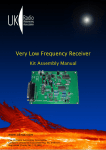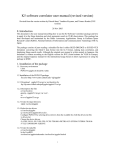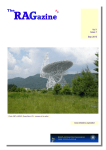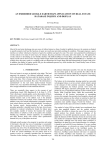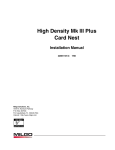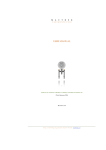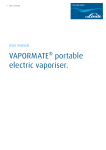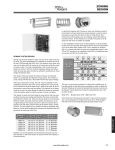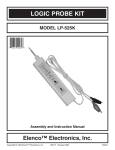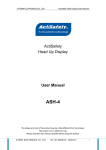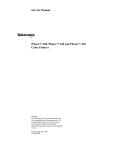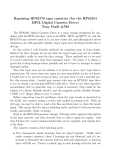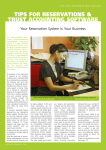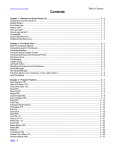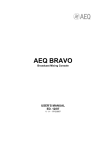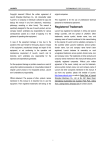Download VLF Aerial Kit Manual
Transcript
Acknowledgements Design Team This aerial design is based on that published by Peter O. Taylor in Observing the Sun (Cambridge University Press 1991). The UKRAA VLF Aerial Kit was designed by Norman Pomfret. Testing Team The UKRAA VLF Aerial was tested by Andrew Lutley and Alan Melia. Production Team The initial batch of the VLF Aerial Kits was produced by Norman Pomfret. Contributors The following authors have contributed to the VLF Aerial Manual: John Cook, Andrew Lutley, Dr Laurence Newell and Norman Pomfret. Issue 1 2010 January 1 © UKRAA Table of Contents Introduction.........................................................................................................................3 UKRAA.............................................................................................................................3 The UKRAA VLF Aerial......................................................................................................3 Support............................................................................................................................3 Tools and Materials Required...............................................................................................4 List of Parts.........................................................................................................................5 Assembly Procedure.............................................................................................................6 First stage: the frame sub-assembly.................................................................................6 Second stage: the frame support clamp............................................................................7 Third stage: the frame base..............................................................................................8 Fourth stage: winding the aerial.......................................................................................8 Fifth stage: final assembly................................................................................................9 Tuning the VLF Aerial.........................................................................................................10 Aerial Characterisation Measurements................................................................................11 Appendix 1 – VLF Aerial Specifications...............................................................................11 Appendix 2 – Regulatory Compliance.................................................................................12 RoHS..............................................................................................................................12 WEEE..............................................................................................................................12 Glossary............................................................................................................................13 Contacts ...........................................................................................................................13 Revision History.................................................................................................................14 Outstanding Work..........................................................................................................14 Issue 1 2010 January 2 © UKRAA Introduction This Manual describes how to construct the UKRAA VLF Aerial from the kit. Please note that the Kit provides only the aerial loop, which must be tuned by a capacitor before it can be used with a receiver. UKRAA can supply a boxed Aerial Tuning Unit (ATU), or you may wish to provide your own variable capacitor. The external capacitor should have a value between approximately 10,000pF and 40,000pF, depending on the frequency of operation. UKRAA The UK Radio Astronomy Association (UKRAA) is a non-profit-making charitable company limited by guarantee. It was established by the Radio Astronomy Group of the British Astronomical Association (BAA) to facilitate the production and sale of radio astronomy products. Any suggestions or recommendations for improvement of this Manual would be appreciated. See the Contacts page for further details. The UKRAA VLF Aerial The UKRAA VLF Aerial is designed to receive VLF radio transmissions at suitable frequencies for the UKRAA VLF Receiver. It is used in conjunction with a tuning unit such as the UKRAA Aerial Tuning Unit, to form a ‘parallel tuned circuit’ to provide an input signal to the Receiver in the frequency range 15-35 kHz. Support All users of the UKRAA VLF Receiver system are encouraged to make use of the support available from UKRAA for setting up and operation. Please see the Contacts section for details. Issue 1 2010 January 3 © UKRAA Tools and Materials Required You will need the following tools and materials to construct the VLF Aerial from the kit: Woodworking adhesive A weight of between about 200g and 500g Varnish and paintbrush Sandpaper A modelling knife A Pozidriv screwdriver Wire cutters Adhesive tape or insulating tape Issue 1 2010 January 4 © UKRAA List of Parts The VLF Aerial kit comprises the following: Part Qty Description 1 2 2 2 3 2 4 1 5 1 6mm nut 6 1 6mm T nut 7 1 8 2 9 2 10 1 11 1 12 1 Picture (not to scale) 580mm x 20mm x 12mm frame cross spars 100mm x 100mm x 9mm ply frame side plates 6mm flat washers 60mm x 6mm machine screw 160mm x 20mm x 12mm clamp base strip 160mm x 100mm x 12mm clamp side plates 50mm x 20mm x 12mm clamp frame guide strips 200mm x 200mm x 6mm base plate 200mm x 200mm x 1.5mm Cork mat Countersunk 20mm x 6mm Posidriv screw Issue 1 2010 January 5 © UKRAA 500g spool of 24 SWG 13 1 enamelled copper wire supplied with kit UKR006 (frame with wire on reel) only 14 12 Cable ties 15 2 Insulation sleeving 16 1 UKRAA Label Please check that your kit contains all of the above parts. Any shortages should be notified to UKRAA (contact details in the Contacts section of the VLF Receiver User Manual) as soon as possible. Assembly Procedure First stage: the frame sub-assembly 1. Apply adhesive to the 12mm rebated central sections of the two frame cross spars (1) and press firmly together. Try to keep the central hole clear of adhesive. 2. Take the two frame side plates (2), noting that each has an outside face with chamfered edges. Lay the first side plate over the centre of the frame cross spars with the corners over the spars. Use a pencil to lightly mark the location of the four side plate corners on the cross spars. Apply adhesive to the cross spars up to the pencil marks and place the first side plate over the cross spars, with the chamfered edges on top. Again, try to keep the central hole clear of adhesive. 3. Put one washer (3) on the 60mm x 6mm machine screw (4), thread the screw down through the central hole in the first side plate and cross spars and invert the assembly. 4. Repeat step 2 above for the second side plate. 5. Put the second washer (3) and the 6mm nut (5) on the machine screw and gently tighten. Issue 1 2010 January 6 © UKRAA 6. If necessary adjust the position of the side plates so that they are in alignment with each other and with the cross spars. 7. Leave to dry. When assembled and with the nut loosened, the frame should be able to rotate on the machine screw, which will facilitate subsequent winding of the aerial coil. 8. Remove the screw, washers and nut. Varnish the frame sub-assembly. We recommend two coats of clear varnish, with a light sanding between coats. Leave to dry. Second stage: the frame support clamp 9. Press the T nut (6) firmly down into the clamp base strip (7) using a vice. If a vice is not available, the T nut can be tapped in with a hammer. Any minor distortion of the clamp base strip side(s) caused by the insertion of the T nut should be made good by filing or sanding the side(s) flat so as to ensure a good mating surface when subsequently gluing to the clamp side plate. 10. Take the two clamp side plates (8), noting that each has an outside face with chamfered edges. Lay the clamp base strip (7) over the inside face of the first clamp side plate – it does not matter which one - as shown below and lightly mark the position of the clamp base strip on the clamp side plate with a pencil. Apply adhesive to the marked area of the clamp side plate and place the clamp base strip on top. Place a suitable weight (200-500g, such as a stapler or the wire spool) on top of the clamp base strip. Check that the clamp base strip is flush with the bottom of the clamp side plate. Leave to dry. Clamp side plate 11. Take the second clamp side plate and place the two frame guide strips (9), as shown below, using the cross spar with the pre-drilled hole as a spacer. The top of the frame guide strips should be flush with the top of the clamp side plate. Mark their position with a pencil, but do not glue them at this stage. Clamp side plate with frame guide strip Issue 1 2010 January 7 © UKRAA 12. Varnish the two clamp plate sub-assemblies and the two frame guide strips (9), as described in step 8 above. NB Do not varnish the surfaces which will be glued in step 13 below or the ‘outside’ surfaces of the frame guide strips. The base plate can also be varnished at this stage as described in step 14 below. Leave to dry. 13. Apply adhesive to the ‘open’ side of the clamp base strip. Using the two frame guide strips as spacers (these must not be glued at this stage), press the two clamp plate subassemblies together and place a suitable weight on top of the assembly as described in step 10 above. Check that the clamp plates are aligned and that the clamp base strip is flush with the bottom of the clamp side plates. Leave to dry. Remove the two frame guide strips. Third stage: the frame base 14. Varnish the top and chamfered edges of the base plate (10), as described in step 8 above. Do not varnish the underside. Leave to dry. 15. Glue the cork mat (11) to the underside of the base plate and place a suitable weight on top of the base plate as described in step 10 above. Leave to dry. Use a sharp bladed modelling knife or Stanley knife to trim the edges of the cork mat flush if necessary. Fourth stage: winding the aerial 16. Use 24 SWG enamelled copper wire for this stage. A 500g spool of 24 SWG enamelled copper wire is supplied with kit UKR006 (frame with wire on reel). It is not included in kit UKR005 (frame only). Suitable wire is available from Rapid (part no 05-0230). Maplin part no YN84 is also suitable but is supplied in 250g reels, which will involve soldering – see step 17 below. It is possible to use slightly thicker or thinner wire, but this will affect the inductance of the tuned aerial, which will affect the capacitance required to tune it to the desired frequency – for further information see Martyn Kinder’s BAA SID VLF Receiver Project website http://www.czd.org.uk/astro/radioastro/sid/index.html. Should you wish to use your own aerial wire, please note that we do not recommend using wire of a smaller diameter, since this will increase the resistance, and hence lower the sensitivity. 17. If it is necessary to join two lengths of enamelled copper wire, use a modelling knife and sandpaper to strip back the enamel coating from about 1 cm at the end of each wire before soldering. 18. Mount the spool of wire on a spindle – a pencil will suffice. The spindle can either be clamped in a vice or hand held – the latter allows slight tension to be applied, which may assist with winding. 19. The aerial frame can either be hand held or mounted on a spindle – the 60mm x 6mm machine screw (4) or a 6mm rod will serve for this purpose. Issue 1 2010 January 8 © UKRAA 20. Using a strip of adhesive tape or insulating tape, secure the end of the wire to the centre of the cross spar member with the pre-drilled hole. Tape the wire again at the end of the spar. 21. Wind 125 turns of wire onto the aerial frame. The precise number of turns is not critical as each turn only has a slight effect on the final inductance of the aerial. 22. Tape the free end of the wire to the same spar member as used in step 20 above and secure with strips of adhesive tape or insulating tape at the end and centre of the spar. 23. Apply the cable ties (14) as shown below – three ties to each side. Cable tie applied to windings Fifth stage: final assembly 24. Remove the adhesive tape or insulating tape applied in steps 20 and 22 above. 25. Thread the two ends of the wire through the lower of the two holes in the clamp side plate, from inside to out. 26. Thread the machine screw (4), using the associated washers, through the clamp side plates and frame spar and gently tighten the nut (5). 27. Thread the countersunk screw (12) through the base plate (10), from the bottom, through the hole in the base strip so that it engages in the T nut. Tighten the screw. 28. Adjust the aerial frame so that the frame is vertical and tighten the central nut (5). 29. Glue in the frame guide strips on either side of the central spar flush with the top of the clamp side plates. 30. Thread the Insulation sleeving (15) over the ends of the aerial wire. 31. Please note that if you intend to mount the UKRAA Aerial Tuning Unit directly to the aerial base, then you should not fit the M6 bolt (4), nut (5) and washers (3), since these will obstruct the ATU. Issue 1 2010 January 9 © UKRAA 32. Apply the UKRAA label to your finished aerial, as shown below. The fully assembled UKRAA VLF aerial Tuning the VLF Aerial Instructions for tuning the VLF Aerial are contained in the VLF Receiver User manual. Issue 1 2010 January 10 © UKRAA Aerial Characterisation Measurements The results of measurements on the UKRAA loop aerial, which give an indication of the frequency response, are contained in the VLF Receiver User manual. The graph below is an example of the response which can be achieved by careful tuning, in this case to 23.4kHz. VLF Receiver Bandwidth at maximum"Q" 2500 Output in mV 2000 1500 1000 500 0 22.6 22.8 23 23.2 23.4 23.6 23.8 24 24.2 Frequency in kHz Frequency Response of UKRAA VLF Aerial Tuned to 23.4kHz Appendix 1 – VLF Aerial Specifications Frequency range Issue 1 2010 January 15-35 kHz 11 © UKRAA Appendix 2 – Regulatory Compliance RoHS The Directive on the restriction of the use of certain hazardous substances in electrical and electronic equipment 2002/95/EC, (commonly referred to as the Restriction of Hazardous Substances Directive or RoHS) was adopted in February 2003 by the European Union. The RoHS directive took effect on 2006 July 1, and is required to be enforced and become law in each member state. This directive restricts the use of six hazardous materials in the manufacture of various types of electronic and electrical equipment. In speech, RoHS is often spelled out, or pronounced “rosh”. The above paragraph was taken from the Wikipedia essay on RoHS. The RoHS Directive restricts the use of the following six hazardous substances in electronic and electrical equipment products falling within the Directive: • Lead • Mercury • Cadmium • Hexavalent chromium • Polybrominated biphenyls • Polybrominated diphenyl ethers UKRAA confirms that the suppliers of the components and materials used in the UKRAA VLF Aerial have stated that such components and materials are RoHS compliant and that reasonable steps have been taken to confirm these statements. WEEE RoHS is closely linked with the Waste Electrical and Electronic Equipment Directive (WEEE) 2002/96/EC that sets collection, recycling and recovery targets for electrical goods and is part of a legislative initiative to solve the problem of huge amounts of toxic e-waste. The Waste Electrical and Electronic Equipment (WEEE) Directive is designed to ensure the efficient collection and recycling of electrical and electronic equipment at end-of-life. If a customer purchases a new product from UKRAA which falls within the WEEE Directive to replace an existing one (of similar function to the one that has been sold) and intends to dispose of the existing one, then the customer can request that we take back the existing product and deal with the costs and logistics of recycling it. Any customer wishing to take advantage of this facility should contact us. Provided that the existing product comes within the scope of the WEEE Directive, we will make arrangements for its return or collection and will deal with its disposal. Issue 1 2010 January 12 © UKRAA Glossary RoHS Restriction of Hazardous Substances SWG Standard Wire Gauge UKRAA The UK Radio Astronomy Association VLF Very Low Frequency WEEE Waste Electrical and Electronic Equipment Contacts The UK Radio Astronomy Association Springfield Rookery Hill Ashtead Park Ashtead Surrey KT21 1HY Limited by Guarantee Reg. No. 6481611 Registered UK Charity No. 1123866 E-mail: [email protected] Website: www.ukraa.com Fax: 0870 132 3728 Telephone: 01372 279066 Starbase Information Website: www.starbase.org BAA Radio Astronomy Group Website: www.britastro.org/radio Issue 1 2010 January 13 © UKRAA Revision History Revision Date Author Status Draft A 2009-08-08 A J Lutley Internal draft for peer review, layout by LMN Issue 1 2010-01-12 L M Newell Incorporated reviewer's comments Outstanding Work None, document is at Issue status Limited by Guarantee Reg. No. 6481611 Registered UK Charity No. 1123866 Issue 1 2010 January 14 © UKRAA















